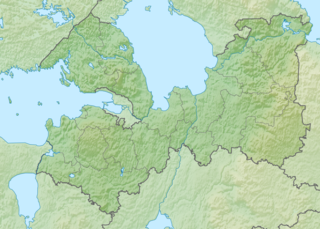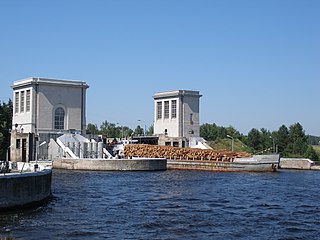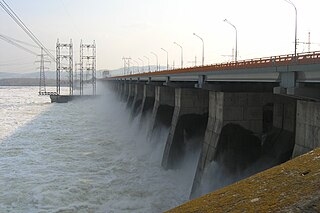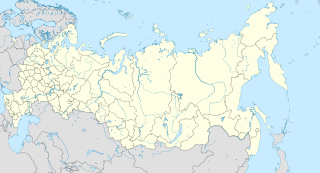| Lower Svir Hydroelectric Station | |
|---|---|
 | |
Location of the Lower Svir Hydroelectric Station in Leningrad Oblast | |
| Official name | Нижнесвирская ГЭС |
| Country | Russia |
| Location | Svirstroy, Leningrad Oblast |
| Coordinates | 60°48′18″N33°42′18″E / 60.80500°N 33.70500°E Coordinates: 60°48′18″N33°42′18″E / 60.80500°N 33.70500°E |
| Status | Operational |
| Opening date | 1933 |
| Owner(s) | TGC-1 |
| Dam and spillways | |
| Impounds | Svir River |
| Power Station | |
| Installed capacity | 99 MW |
Lower Svir Hydroelectric Station (Russian : Нижнесвирская ГЭС) is a hydroelectric station on the Svir River located in the urban-type settlement of Svirstroy, Leningrad Oblast, in northwestern Russia. It was open on December 19, 1933 and has the total power of 99 MW. It is operated by the TGC-1 power company. [1]

Russian is an East Slavic language, which is official in the Russian Federation, Belarus, Kazakhstan and Kyrgyzstan, as well as being widely used throughout Eastern Europe, the Baltic states, the Caucasus and Central Asia. It was the de facto language of the Soviet Union until its dissolution on 25 December 1991. Although nearly three decades have passed since the breakup of the Soviet Union, Russian is used in official capacity or in public life in all the post-Soviet nation-states, as well as in Israel and Mongolia.

The Svir is a river in Podporozhsky, Lodeynopolsky, and Volkhovsky districts in the north-east of Leningrad Oblast, Russia. It flows westwards from Lake Onega to Lake Ladoga, thus connecting the two largest lakes of Europe. It is the largest river flowing into Lake Ladoga. The length of the Svir is 224 kilometres (139 mi), whereas the area of its drainage basin is 84,400 square kilometres (32,600 sq mi). The towns of Podporozhye and Lodeynoye Pole, as well as urban-type settlements Voznesenye, Nikolsky, Vazhiny, and Svirstroy are located at the banks of the Svir.
Urban-type settlement is an official designation for a semi-urban settlement, used in several Eastern European countries. The term was historically used in Bulgaria, Poland, and the Soviet Union, and remains in use today in 10 of the post-Soviet states.
Svir is a part of the Volga–Baltic Waterway, connecting the basins of the Volga and the Neva Rivers, with heavy cargo and cruise traffic. To accommodate the waterway, a lock was built to bypass the dam of the power station.

The Volga–Baltic Waterway, formerly known as the Mariinsk Canal System, is a series of canals and rivers in Russia which link the Volga River with the Baltic Sea via the Neva River. Volga–Baltic Waterway connects the biggest lake on Earth, the Caspian Sea to the World Ocean. Its overall length between Cherepovets and Lake Onega is 368 kilometres (229 mi).
The construction started in 1927 and was coordinated by Genrikh Graftio, who had been responsible for the construction of the Volkhov Hydroelectric Station. The construction was complicated by the fact that the ground in the area is soft, and the dam was built with certain angle to the riverbed, so that the water pressure pushed it to the ground. The construction was completed in 1933. During World War II, the Svir separated Soviet (south) and Finnish (north) troops, and the dam was destroyed. It was restored after the war. [2] The name of the station was originally the Svir Hydroelectric Station.

Genrikh Osipovich Graftio was a Russian/Soviet engineer credited as a pioneer of the hydroelectric station construction, as one of the founders of the GOELRO plan, and notable for the construction of the first hydroelectric stations in the Soviet Union, the Volkhov Hydroelectric Station in Volkhov and the Lower Svir Hydroelectric Station in Svirstroy.

Volkhov hydroelectric plant, named after V.I. Lenin, is a hydroelectric station on the Volkhov River located in the town of Volkhov, Leningrad Oblast, in northwestern Russia. It is the oldest and longest serving hydroelectric plant in Soviet Union and Russia. It is a part of the Ladoga cascade.

World War II, also known as the Second World War, was a global war that lasted from 1939 to 1945. The vast majority of the world's countries—including all the great powers—eventually formed two opposing military alliances: the Allies and the Axis. A state of total war emerged, directly involving more than 100 million people from over 30 countries. The major participants threw their entire economic, industrial, and scientific capabilities behind the war effort, blurring the distinction between civilian and military resources. World War II was the deadliest conflict in human history, marked by 50 to 85 million fatalities, most of whom were civilians in the Soviet Union and China. It included massacres, the genocide of the Holocaust, strategic bombing, premeditated death from starvation and disease, and the only use of nuclear weapons in war.
Since 1955, the Lower Svir Hydroelectric Station and the Upper Svir Hydroelectric Station, located in Podporozhye, perform coordination and, in particular, jointly regulate the water level in the Svir. [3]

Upper Svir Hydroelectric Station is a hydroelectric station on the Svir River located in the town of Podporozhye, Leningrad Oblast, in northwestern Russia. It was open on February 13, 1952 and has the total power of 160 MW. It is operated by the TGC-1 power company.

Podporozhye is a town and the administrative center of Podporozhsky District in Leningrad Oblast, Russia, located on the Svir River 285 kilometers (177 mi) northeast of St. Petersburg. Population: 18,733 (2010 Census); 20,312 (2002 Census); 23,295 (1989 Census).
The station was named after Genrikh Graftio. [4]














